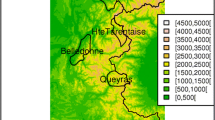Abstract
A method is presented for elevation (H) and spatial position (X, Y) decorrelation stretch of annual precipitation summaries on a 1-km grid for SW USA for the period 2003 to 2014. Multiple linear regression analysis of the first and second principal component (PC) quantifies the variance in the multi-temporal precipitation imagery that is explained by X, Y, and elevation (h). The multi-temporal dataset is reconstructed from the PC1 and PC2 residual images and the later PCs by taking into account the variance that is not related to X, Y, and h. Clustering of the reconstructed precipitation dataset allowed the definition of positive (for example, in Sierra Nevada, Salt Lake City) and negative (for example, in San Joaquin Valley, Nevada, Colorado Plateau) precipitation anomalies. The temporal and spatial patterns defined from the spatially standardized multi-temporal precipitation imagery provide a tool of comparison for regions in different geographic environments according to the deviation from the precipitation amount that they are expected to receive as function of X, Y, and h. Such a standardization allows the definition of less or more sensitive to climatic change regions and gives an insight in the spatial impact of atmospheric circulation that causes the annual precipitation.
















Similar content being viewed by others
References
Aschonitis, V., Miliaresis, G., Demertzi, K., & Papamichail, D. (2016). Terrain segmentation of Greece using the spatial and seasonal variation of reference crop evapotranspiration. Advances in Meteorology, 2016, 14. doi:10.1155/2016/3092671.
Barnett, T. P., & Pierce, D. W. (2008). When will Lake Mead go dry? Water Resources Research, 44, W03201. doi:10.1029/2007WR006704.
Crouch, J. (2015). The highs and lows of climate. Beyond the Data (Blog). NOAA. https://www.climate.gov/news-features/blogs/beyond-data/highs-and-lows-climate. Accessed 15 Nov 2015.
Demertzi, K., Papamichail, D., Aschonitis, V., & Miliaresis, G. (2014). Spatial and seasonal patterns of precipitation in Greece: the terrain segmentation approach. Global NEST Journal, 16, 988–997.
Dore, A. J., Mousavi-Baygi, M., Smith, R. I., Hall, J., Fowler, D., & Choularton, T. W. (2006). A model of annual orographic precipitation and acid deposition and its application to Snowdonia. Atmospheric Environment, 40(18), 3316–3326.
Farr, T. G., & Kobrick, M. (2000). Shuttle radar topography mission produces a wealth of data. American Geophysical Union EOS, 81, 583–585.
Kidd, C., & Huffman, G. (2011). Global precipitation measurement. Meteorological Applications, 18, 334–353.
Landam, S., & Everitt, B. S. (2004). A handbook for statistical analyses using SPSS. New York: Chapman and Hall/CRC Press.
Lillesand, T., Kiefer, R. W., & Chipman, J. (2015). Remote sensing and image interpretation (7th ed.). New York: Wiley.
Lionello, P., Malanotte-Rizzoli, P., & Boscolo, R. (Eds.). (2006). Mediterranean climate variability. Amsterdam: Elsevier.
Miliaresis, G. (2012a). Elevation, latitude/longitude decorrelation stretch of multi-temporal LST imagery. Photogrammetric Engineering & Remote Sensing, 78, 151–160.
Miliaresis, G. (2012b). Selective variance reduction of multi-temporal LST imagery in the East Africa rift system. Earth Science Informatics, 5, 1–12.
Miliaresis, G. (2012c). Elevation, latitude and longitude decorrelation stretch of multi-temporal near-diurnal LST imagery. International Journal of Remote Sensing, 33, 6020–6034.
Miliaresis, G. (2013a). Terrain analysis for active tectonic zone characterization, a new application for MODIS night LST (MYD11C3) dataset. International Journal of Geographical Information Science, 27, 1417–1432.
Miliaresis, G. (2013b). Thermal anomaly mapping from night MODIS imagery of USA, a tool for environmental assessment. Environmental Monitoring and Assessment, 185, 1601–1612.
Miliaresis, G. (2014a). Daily temperature oscillation enhancement of multi-temporal LST imagery. Photogrammetric Engineering & Remote Sensing, 80, 423–428.
Miliaresis, G. (2014b). Spatiotemporal patterns of land surface temperature of Antarctica from MODIS monthly LST data (MYD11C3). Journal of Spatial Science, 59, 157–166.
Miliaresis, G., & Argialas, D. (1999). Segmentation of physiographic features from the global digital elevation model/GTOPO30. Computers & Geosciences, 25, 715–728.
Miliaresis, G., & Argialas, D. (2000). Extraction & delineation of alluvial fans from DEMs & Landsat TM images. Photogrammetric Engineering & Remote Sensing, 66, 1093–1101.
National Atlas (2014). The national atlas of the United States of America (1997–2014 edition). USGS. http://nationalmap.gov/small_scale/. Accessed 15 Nov 2015.
Pidwirny, M. (2006). Introduction to the hydrosphere. Fundamentals of physical geography, 2nd Edn. http://www.physicalgeography.net/fundamentals/chapter8.html Accessed 15 Nov 2015.
SRTM30 (2005). 30 arc sec SRTM digital elevation model (Ver. 2.1.). Shuttle Radar Topography Mission. NASA http://dds.cr.usgs.gov/srtm/version2_1/ Accessed 15 Nov 2015.
Thenkabail, P. S., Knox, J. W., Ozdogan, M., Gumma, M. K., Congalton, R. G., Wu, Z., Milesi, C., Finkral, A., Marshall, M., Mariotto, I., You, S., Giri, C. P., & Nagler, P. L. (2012). Assessing future risks to agricultural productivity, water resources and food security-how can remote sensing help? Photogrammetric Engineering & Remote Sensing, 78, 773–782.
Thornton, P. E., Running, S. W., & White, M. A. (1997). Generating surfaces of daily meteorological variables over large regions of complex terrain. Journal of Hydrology, 190, 214–251.
Thornton, P.E., Thornton, M.M., Mayer, B.W., Wilhelmi, N., Wei, Y., Devarakonda, R., & Cook, R.B. (2014). Daymet: daily surface weather data on a 1-km grid for North America, Version 2. ORNL DAAC, Oak Ridge, Tennessee, USA. http://dx.doi.org/10.3334/ORNLDAAC/1277. Accessed 15 Nov 2015.
Wang, S. Y., & Gillies, R.R. (2012). Climatology of the U.S. inter-mountain west. In S.-Y. Wang, & R.R. Gillies (Eds.), Modern climatology, 398 p. (pp. 153–176). InTech.
Acknowledgments
The author is grateful and this paper was benefited significantly from the suggestions and corrections of the two anonymous reviewers.
Author information
Authors and Affiliations
Corresponding author
Rights and permissions
About this article
Cite this article
Ch. Miliaresis, G. Spatial decorrelation stretch of annual (2003–2014) Daymet precipitation summaries on a 1-km grid for California, Nevada, Arizona, and Utah. Environ Monit Assess 188, 361 (2016). https://doi.org/10.1007/s10661-016-5365-5
Received:
Accepted:
Published:
DOI: https://doi.org/10.1007/s10661-016-5365-5




